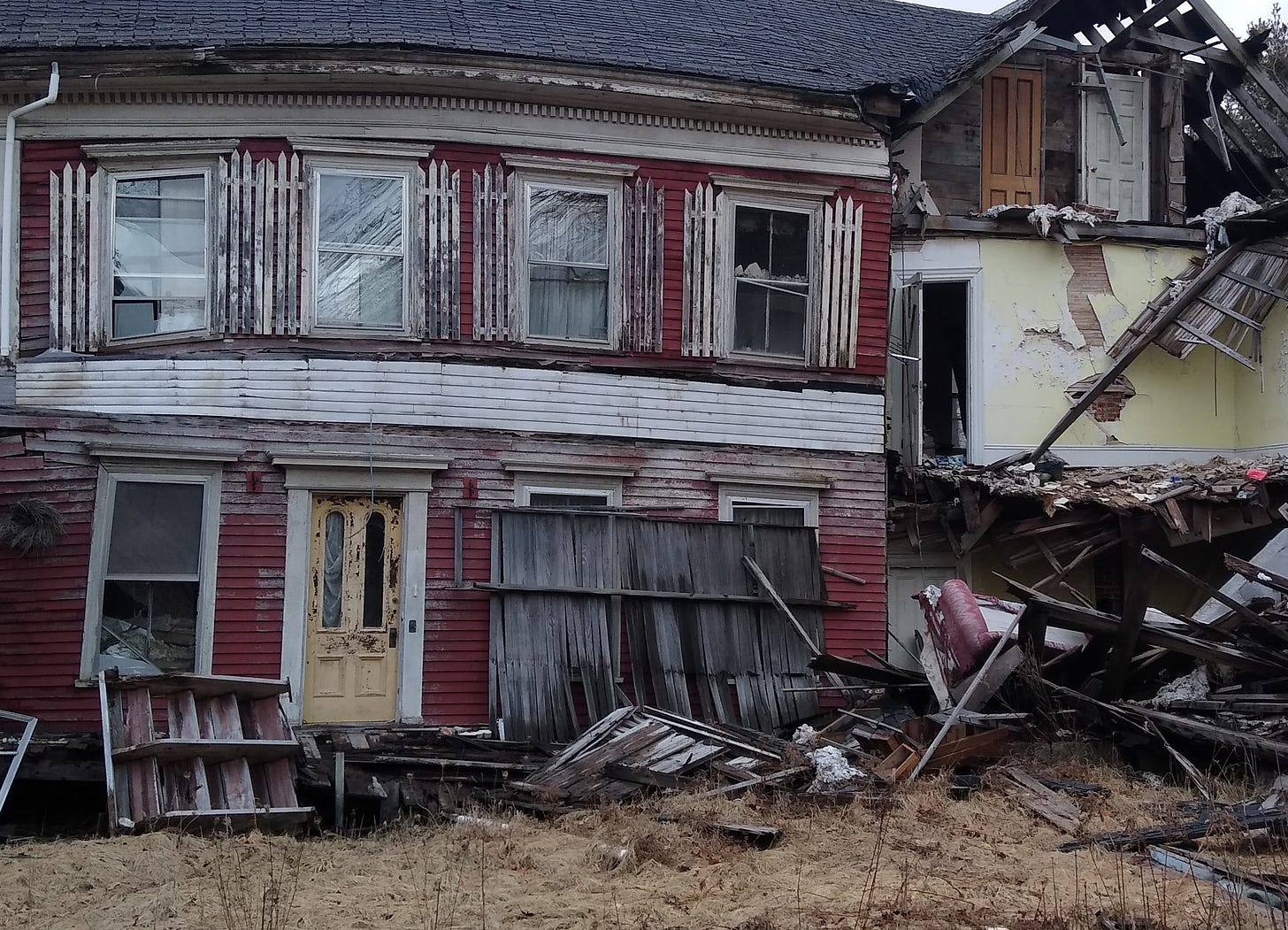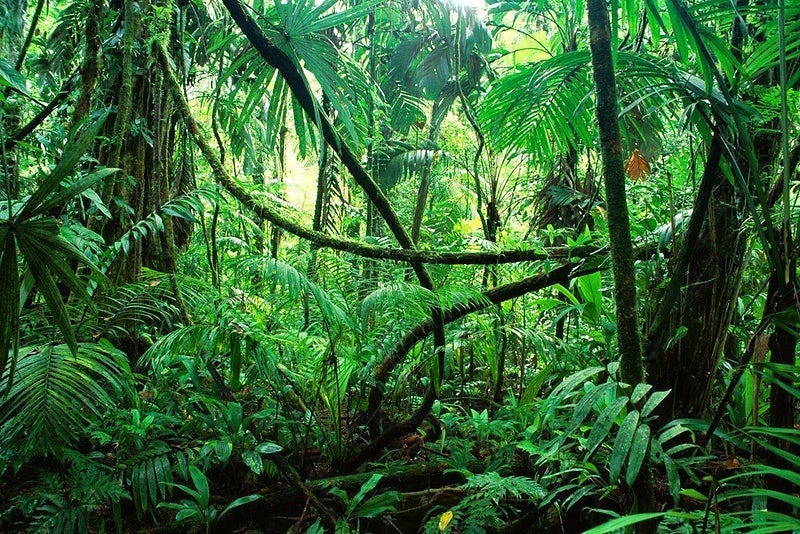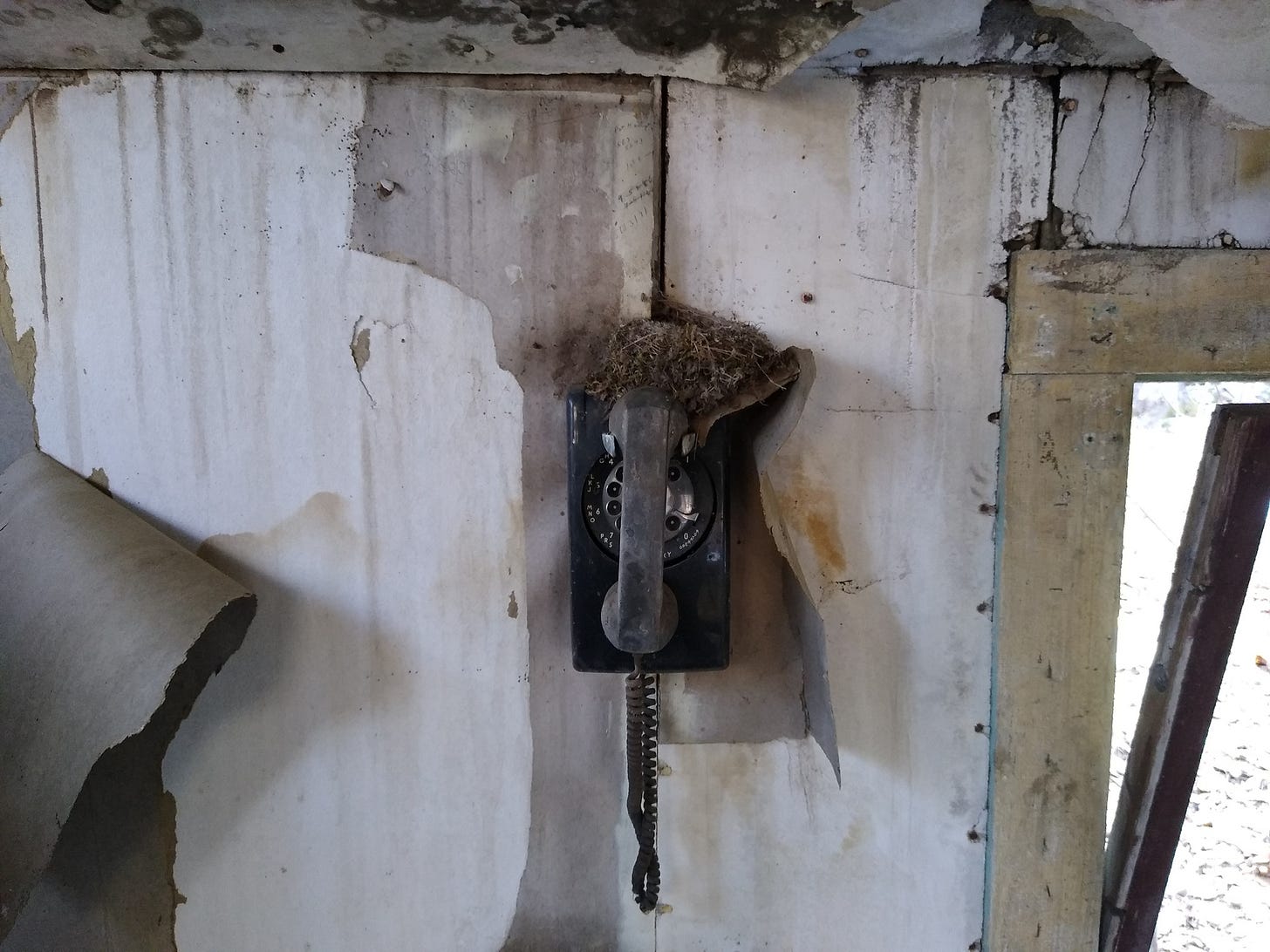Tipping Points: An Introduction – part 2 of 2
3/7/24 – How and why some Earth systems may suddenly collapse
Hello everyone:
For those of you interested in listening to rather than reading these Field Guide essays, I have finally recorded a few recent ones: Running AMOC, Who is We?, and Consciousness is Organic. You can also find them by clicking on the Field Guide’s podcast tab. These read-alouds are very much a work in progress – especially my vocal work – and they only cover the main essay. For the full Field Guide experience, reading is still the way to go, since the essays contain the photos, graphics, and curated Anthropocene news that the audio does not.
My rationale for providing these recordings is to bring in subscribers more interested in audio, and to reward paid subscribers. For now, though, as I work out the bugs, they’re free for all subscribers. Let me know what you think.
Also, if you want to do something for Ukraine’s defense rather than waiting for House Republicans to come back to the logic of defending allies and democracies, see what Timothy Snyder has been doing and what he recommends.
As always, please remember to scroll past the end of the essay to read this week’s curated Anthropocene news.
Now on to this week’s writing:
Note to new subscribers: You may want to begin with last week’s writing. We’re neck-deep in a litany of tipping points, which are the major Earth systems that research suggests will likely tip into new chaotic states if we don’t quickly rein in human ecological impacts.
I took a while last week to get to a definition of tipping points, so I’ll offer a short, sweet riff on it here. Identifying tipping points across the globe provides a map of a particular kind of relationship. On one hand, this isn’t surprising. We live on a planet in which all of life is woven together by relationships, whether with each other or with the biogeophysical processes that set the conditions for life. Energy flows from the Sun through living cells and through air, water, stone, and fire. In a process so elegant, beautiful, and astonishing we should still be worshiping it, life sets the conditions for life.
But much of what defines the Anthropocene is our disruption of Earth’s capacity to set those conditions. Tipping points are the now-foreseen events in which our disruptions suddenly and often irreversibly change how the living world works.
The Anthropocene is also defined by the stark reality that we are “managing” the planet. We are neither philosophically nor technologically mature enough for that job, and the more mature we become the more we should understand that. From any rational perspective, our role should be to heal, as best we can, what we’ve harmed.
To that end, it’s worth remembering, as I’ve often said and as @Rob Lewis at @The Climate According to Life often explains, that it’s not quite accurate to say we’re in the midst of a climate crisis. We’re in a global ecological crisis, of which the rapidly heating climate is the most talked-about feature. But the larger destruction of the living world is the real story. The more land we harm, or “convert” from living systems to human resource, the more extinctions are likely and the more the climate, which is shaped by the energy flowing through green systems, is changed. In this sense, tipping points are measures of how far down the wrong path we’ve gone.
We falsely believe we’re the beneficiary of Earth’s energy flows rather than only a bright node within it. As Rob writes, “Do we not have a relationship with these lands? Does not everything living upon them depend utterly on our willingness to let them live?”
With that in mind, then, let’s return to the Global Tipping Points Project and finish our quick survey of some assessed tipping points in the biosphere, i.e. the green Sun-fed world.

Tropical Forests
The Amazon, Congo, and Southeast Asian rainforests are home to many of Earth’s species, and they are fundamental drivers of global climate. The stability of these systems should be of paramount importance. But, particularly in the Amazon, deforestation and warming are already increasing the length of the dry season, worsening drought and fire, and causing more extreme precipitation, all of which in turn increase mortality throughout the forests.
The primary mechanisms at play here are the forest-rainfall and fire-vegetation feedback loops. These vast forests generate much of their own precipitation through transpiration and cloud formation. As a Grist piece explains, trees “suck up water from the soil through their trunks — like liquid through a straw — and exhale it into the atmosphere through little pores on the undersides of leaves… Transpiration cools the rainforest and produces rainfall. So if the forest is cut down, the surrounding area dries out.” Loss of forest decreases available moisture, which then leads to greater loss of forest. Likewise, increased fires decrease canopy and thus available moisture, making it unlikely that forest will grow back in fire-prone areas.
Portions of the Amazon where, as an excellent Times article explains, “the rain machine is slowing,” seem likely to convert to grasslands or savanna. Research suggests that over 75% of the Amazon has “lost resilience” since 2000, and that the region has shifted from a CO2 sink to a CO2 emitter.
Boreal Forests
Boreal forests occupy northern North America and Eurasia, storing 65% of the world’s forest carbon (more than twice as much as tropical forests), mostly in its soils and permafrost. Estimates suggest that at around 3°C to 4°C of warming, the southern edge of boreal forests will die-off and shift toward treeless steppe or prairie. Along the northern edge, it is expected that boreal forest will expand into what is now tundra, though perhaps more slowly. The relative speed of southern die-off vs. northern expansion will determine the long-term viability of the boreal forests, one of the largest and most vital ecosystems on the planet.
Moreover, all of this takes place with some uncertainty regarding the impact of increased boreal forest loss from insects and fires in a warming world. Boreal forests evolved with fire, but the scale of annual wildfires now is far beyond the norm. (Nearly 27 million acres burned in Siberia in 2020, as temperatures soared over 100°F in the Russian Arctic.) A crucial carbon sink, the boreal forest may soon become a carbon emitter.
Temperate Forests
Very few intact temperate forests remain, due to human conversion of these ecosystems for agriculture and forestry. Much of what remains is young, less diverse, and fragmented, or at worst simply plantation monoculture for timber. As a result, general biodiversity and the water cycle in these regions have both been deeply disturbed, and the remaining forests are much less resilient against the impacts of a warmer world than they once were.
A direct temperature-based feedback loop is hard to identify, but the same dynamics apply here as in tropical forests. The water cycle is disturbed as temperate forests fragment from deforestation, climate-related drought, fires, and invasive insect damage, which then makes further die-off likely. It is possible, then, that a tipping point for these forests will be reached because of direct human activity rather than by the indirect impacts of climate change.
(For a useful comparison of tropical, boreal, and temperate forests, check out some analysis from the Woodwell Climate Research Center.)
Savannas and Grasslands
Savannas and grasslands around the globe are being substantially lost or degraded from conversion to agriculture (grazing especially), from forest growth due to fire suppression (by people) and monoculture plantations, and from invasive grass species. Increased CO2 may favor tree growth where grasses once dominated. The rich biodiversity associated with grassland ecosystems suffers as these rapid changes occur.
Some evidence suggests that grasslands/savannas, which evolved with fire, may rapidly tip toward forest as fire suppression increases forest growth and trees cover up to 50% of the habitat. At that point, fire becomes even less likely, which then accelerates further loss of savanna.
Drylands
Drylands is a broad category including deserts, shrublands, and various types of dry forest ecosystems. But together they cover nearly half the Earth and are home to 38% of the human population. Looking through the GPT project assessment, it’s clear that these landscapes can change quickly and, in some cases, irreversibly, especially under pressure from decreased rainfall and increased fire and soil disturbance. But too little is known about the specific processes to identify clear tipping points.
Lakes and Ponds
Lakes and ponds provide well-known examples of tipping points, most notably eutrophication and anoxia, when excess phosphorus from waste water and agricultural run-off feed algae blooms which then consume much of the waterborne oxygen. Eutrophication may be enhanced by a hotter climate, as warmer water decreases circulation and heavier rain increases run-off. Eutrophic lakes and ponds also release more methane than healthier ones.
Elsewhere, in boreal regions freshwater bodies are getting murkier and more anoxic, while in the high Arctic ponds are forming in the permafrost and releasing large amounts of greenhouse gases. In both these cases there’s a straightforward feedback loop as their contributions to a hotter world increase the likelihood that more greenhouse gases will be released.
Coral Reefs
Warm-water coral reefs support a quarter of all marine species, and feed and employ half a billion people. At 2.0°C (3.6°F) of warming, it’s likely that nearly all warm-water coral reefs will die of thermal stress. We’re nearly at 1.5°C of warming, which has been forecast to kill off 70-90% of corals. But recent analysis suggests that the tipping point for mass coral bleaching events already occurred when we reached 1.2°C, and that the fate of corals is already determined.
As heat does most of the killing, an increasingly acidic ocean (from absorbing our excess CO2) is making it harder for corals to form their skeletons. And pressure from overfishing and pollution is stressing some coral reef communities to the point where their susceptibility to thermal stress is increased.
Thus, with well-defined tipping points so close to hand, widespread reef community collapse is expected in the near-future if we don’t immediately reverse course on emissions and warming.
Mangrove Forests and Seagrass Meadows
Mangrove forests and seagrass meadows are important coastal ecosystems around the globe, providing nursery habitat, cycling nutrients, capturing CO2 and sediment, and protecting against storm surge. They are vulnerable, though, to human-induced changes on both land and sea, and face substantial threats from more intense storms, erasure by human development, atmospheric and marine heatwaves, ocean acidification and deoxygenation, drought and sedimentation, invasive species, changes in salinity, and sea level rise.
As these threats compound, and as hurricanes and cyclones hit coasts harder and with more frequency, mangroves especially struggle to recover after being damaged by storms. At 1.5°C to 2.0°C, it appears that mangrove and seagrass communities will reach tipping points in their ability to cope with these compounding threats, particularly in areas where habitat is already harmed by direct human activity.
As with coral reefs, the cost of losing such vital habitats on a regional or global scale is hard to quantify or even imagine, given how essential they are for biodiversity and for human communities around the planet.
Kelp Forests
Kelp forests provide many of the same benefits and face many of the same threats as mangrove forests and seagrass meadows. But kelp forests have been decimated worldwide mainly by a combination of marine heatwaves and increased purple sea urchin populations. Warmer waters threaten kelp forests on their own, but they have also caused a die-off of sunflower sea stars, the urchins’ main predators. Long-term human predation of sea otters, who feed on urchins, has also been a key factor on the west coast of North America.
Like shrublands turning into desert or the Amazon converting to savanna, kelp forests are likely to become and remain “urchin barrens” because of certain feedbacks. Urchin populations are remarkably resilient once established, and kelp cannot reestablish itself if the urchins are present in sufficient numbers. Even if, as is happening in some areas, human intervention to reduce urchin numbers succeed, the kelp forests that begin to rewild are facing a hotter, less familiar ocean. Still, human intervention is a must, whether to reduce urchin populations, restore sea star populations, breed kelp to help reestablish forests, or all of the above.
This list of tipping points, together with the 11 systems that I discussed last week, is only a selection from the numerous systems assessed by the Global Tipping Points project. I refrained from discussing, for example, ocean deoxygenation, the collapse of fisheries, the ocean’s carbon-sequestering biological pump, and a host of subcategories of everything from monsoons to commercial fish stocks.
The GTP project’s long list, in turn, is only a selection from the innumerable relationships between Earth systems, and between human activity and those systems. Earth is less a place than an infinite web of relationships, from space weather down to local weather and from plateaus to plankton.
Speaking of plankton, if this discussion of tipping points has been new and useful to you, you may start noticing discussion of tipping points in the news. Grist ran an article in June about how plankton, which anchor the entire oceanic food web, could become carbon emitters rather than carbon sinks. A Times piece in January explained how snow in the northern hemisphere reaches a negative feedback loop around an average winter temp of 17°F. “Beyond that threshold,” one researcher said, “we kind of see everybody go off a cliff.” Many media sources have been covering recent research into a possible AMOC collapse. And so on.
And, just so you know, I’ve barely scratched the surface of the GTP project assessment. Everything I’ve derived here this week and last is from a portion of Section 1. I could easily spend another month of Sundays exploring the report. Section 1.5, for example, dives into the likely and possible interactions between these tipping points.
Section 2 focuses on the threats that Earth system tipping points pose to human society, both physically (e.g. from AMOC collapse, Amazon die-off, increased heat, etc.) and socially (increased catastrophes can increase political gridlock, polarization, financial stress, migration, etc.). As the world grows chaotic, so might societies, via negative social tipping points and a cascade failure of governance.
But before you despair, Section 3 addresses at great length the kinds of governance necessary to face Earth system tipping points that have arrived or are on the horizon, and Section 4 “investigates the opportunities for positive social tipping points.” Positive social tipping points (PTPs) are defined as
a change in a system or subsystem, which becomes self-reinforcing beyond a critical threshold, and which leads to substantial, frequently abrupt and often irreversible impacts that are predominantly beneficial.
More to the point, PTPs are methods by which we change social norms to substantially reduce the threat of Anthropocene harms and create a world in which life and human communities can flourish. Some of these good tipping points are technological. The most-cited example is how renewable energy sources have suddenly become the cheapest, most sensible, and most popular sources of energy. Likewise, EVs have reached a tipping point in sales in some markets and look likely to become ubiquitous around the globe in a matter of years. You can see the feedback loops at work: Who will want to invest in fossil fuels or drive a gas-hog when there are much better options?
The goal is a cascade effect in which we force these good social tipping points to act as leverage against negative Earth tipping points. Shift culture → shift energy systems → shift emissions → shift rate of warming → shift likelihood of AMOC collapse or coral reef die-off.
In purely social terms, we’ve always lived with the likelihood of good tipping points. The patient work of activists in the last century created what seemed like the sudden acceptance of, say, voting rights, bans on smoking, and the legalization of gay marriage here in the U.S. The current political moment now seems hopeless for positive irreversible shifts like the Green New Deal, a ban on fracking, or a phase-out of most plastics, but the groundwork is being laid and those moments may come if we do the work and rise to the occasion.
Much of this work is as much moral or ethical as it is legal and social: If we make shameful things like deforestation, extinctions, and PFAS contamination shameful at scale, we rebuild society around those new ethics.
A better world can fall into place as easily as it can fall apart. We just need to make the right calls.
Thanks for sticking with me.
In other Anthropocene news:
From Chloe Hopeand Death & Birds, “Visitors,” yet another of her gorgeous and sensitive short personal essays that somehow weave together death and birds and you and I, moving us through the eye of our conscious needle to attend to grief and beauty:
Being both in love with and devastated by life makes for a strange and paradoxical state, and for those of us daring to pay attention it is largely unavoidable. But, when we simultaneously hold two opposites we are Birds mid-flight; balanced, expansive and exquisitely alive.
From the New Yorker, want to take a break worrying about the weather? Worry about space weather instead! “What a Major Solar Storm Could Do to Our Planet” lays out the fascinating tale of what happens when a solar flare aims toward Earth. Having been in a very remote Antarctic camp when solar flares cut off all communication, I can relate to the story. If nothing else, though, we can take some old-fashioned pleasure in thinking about catastrophes that aren’t caused by people.
From Grist, environmental tactics of Israel’s war in Gaza has encouraged the movement to make ecocide a crime punishable by the International Criminal Court (ICC) in the Hague.
From Anthropocene, a new way of assessing the biodiversity impact of food highlights the complexity of the issue. The researchers assessed popular meals around the world, rather than single food sources, and found that even rice and lentils, if grown on land converted from biodiverse tropical ecosystems, had serious impacts. Meat dishes were worse, but the difference is not as simple as meat vs. vegetables.
Three from the Times:
Good news: Maine is falling in love with heat pumps, installing them faster than any other state. As with the comprehensive acceptance of heat pumps in Scandinavia, this is further evidence that the pumps work perfectly well as a primary heat source in cold weather.
Sort of good news: Congress may actually pass sweeping legislation to encourage the next generation of nuclear power plants in the U.S., but it’s not clear how much difference it will make for a clean power source that’s slow and expensive to build.
News that should be better: The Biden administration is permanently lifting the ban on summer sales of ethanol. While this is a small loss for the fossil fuel industry, the article fails to mention 1) the enormous cost to biodiversity in North America from the vast amount of land locked into growing corn for ethanol, 2) the subsequent increase in fertilizer use and water pollution, and 3) the actual worsening of climate change by ethanol because healthy green ecosystems were converted to tilled corn monoculture. The sooner EVs make ethanol obsolete, the better.
From Yale e360, the solar revolution is a boon for small-scale farmers, allowing them to pump water more cheaply and cleanly. But this is coming at a cost to the world’s groundwater supply.
From Inside Climate News, interesting new research ties the warming-related surge of freshwater from the Arctic into the North Atlantic to heat waves and droughts in Europe. The research may prove a useful forecasting tool for Europe, but it also suggests that contrary to current theory a slowing of the AMOC might make Europe hotter rather than colder. Stay tuned…
From Heated, “Plastic Recycling is a Scam,” an excellent and informative screed against the lies and disinformation campaign by the fossil fuel and plastics industry about plastic recycling. The industry has known for decades that recycling did not and could not make a difference in reducing plastic waste.







Thanks for your great response Jason and I totally agree and I do have hope. The human tipping point is one to think about as it relates to larger change. I see myself as a teacher in my commitment to an active, chemical free landscape in a suburban setting where I get questions about what I'm doing. One person strolling by asked me if I lived here or worked here, ha, ha. I recently moved from an idyllic 6 acres in MA (you might wonder why), to CT where every day I see more upland forest falling for housing and the increasing issues of building and removing trees , the disruption to the understory and the increasing issues of where all the water goes. It all starts with empathy. Every time I release a butterfly with my grandchildren I know that their feelings for the natural world continue. The work is is one of addition, whole systems as you've described. The timing is crucial. Not sure what I would do without Heather, my thanks to you both!!
Isn’t this absence of morality its own tipping point? If mankind is groomed to no longer care or dumbed down to be unaware how can an understanding of ecological systems ever be understood. Remember how we used to collect tadpoles in grade school and observe the process of them becoming frogs? We need the process of slow learning and observation to “get”our place in all the systems you describe here.